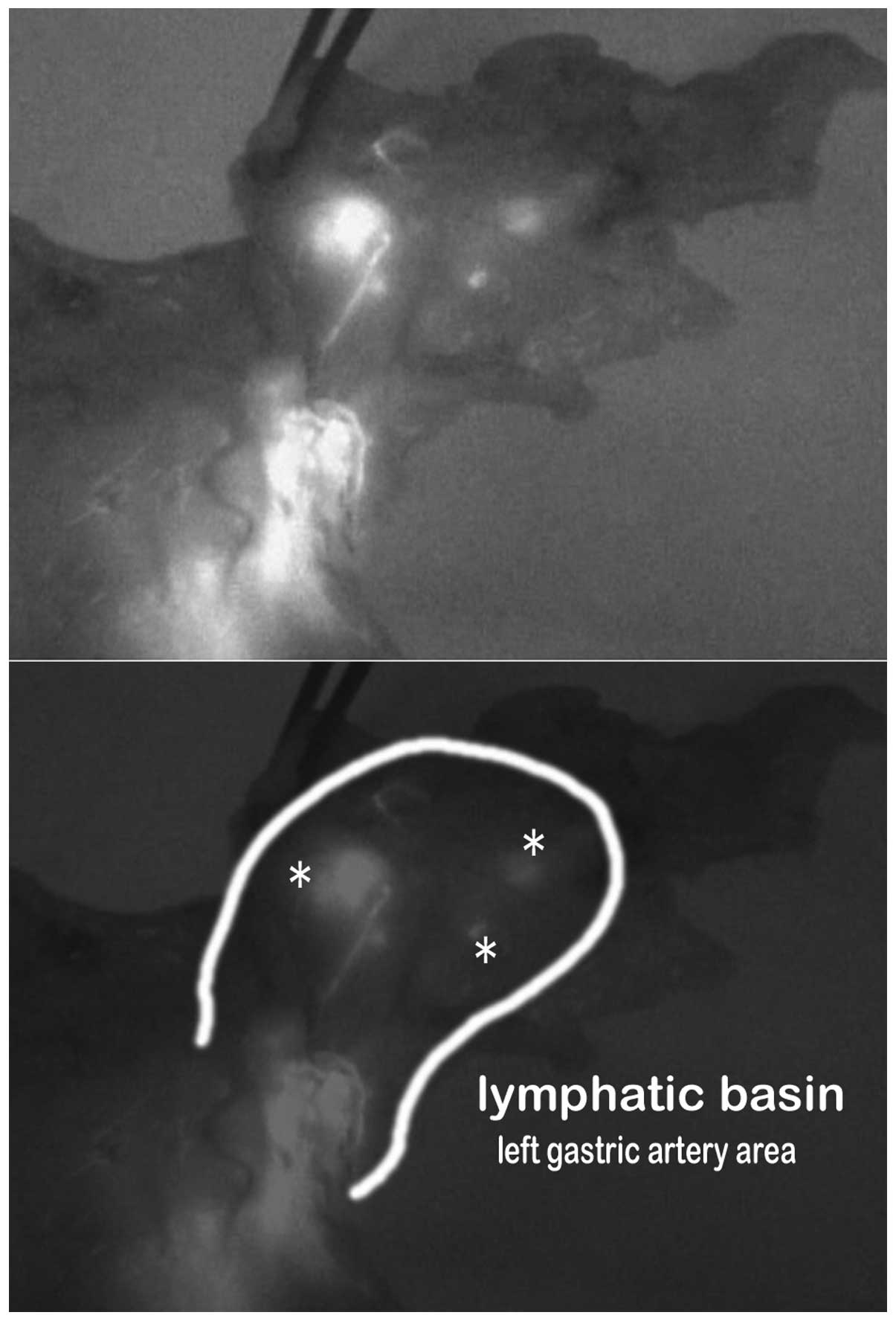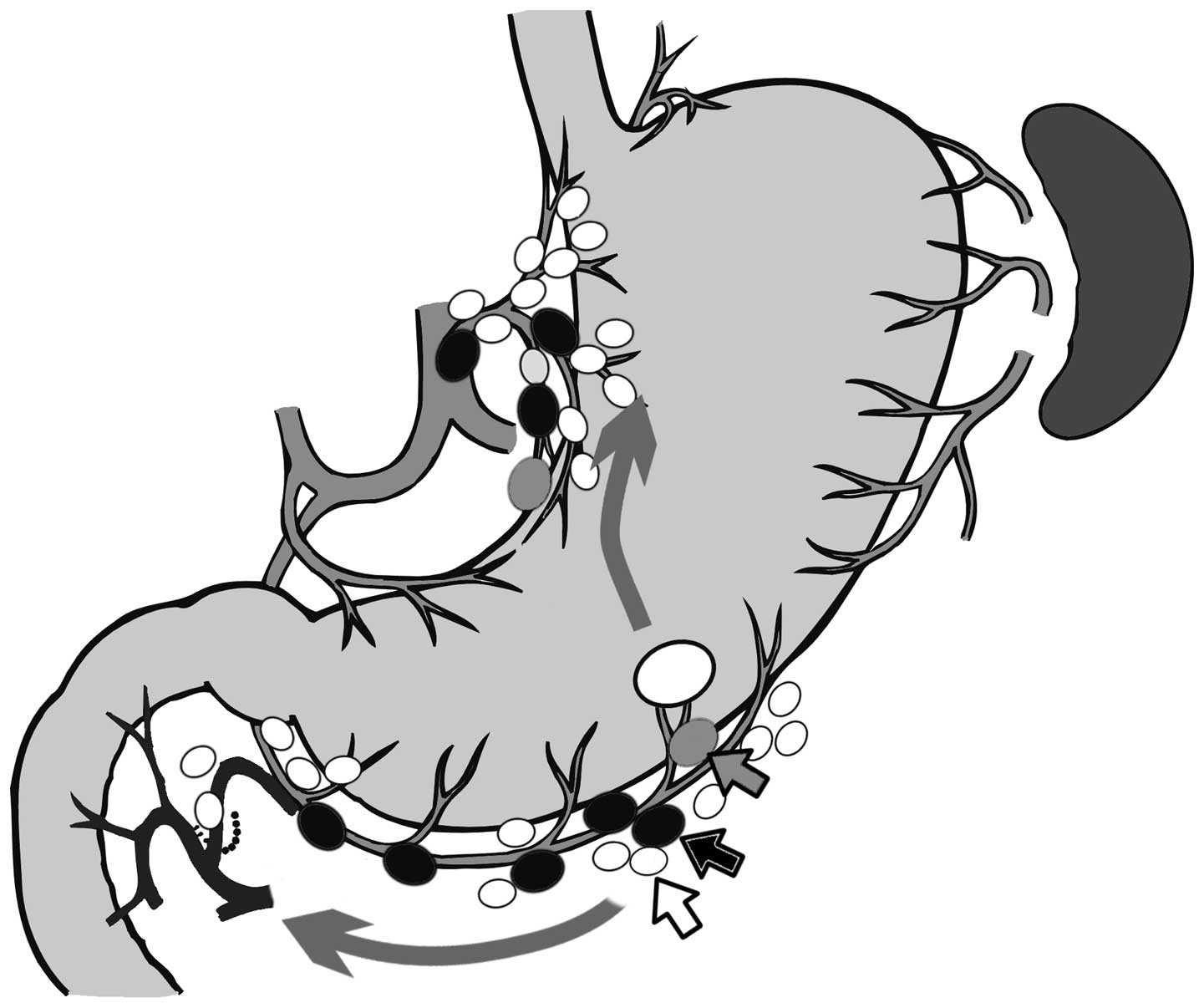|
1
|
Eagon JC, Miedema BW and Kelly KA:
Postgastrectomy syndromes. Surg Clin North Am. 72:445–465.
1992.PubMed/NCBI
|
|
2
|
Morton DL, Wen DR, Wong JH, Economou JS,
Cagle LA, Storm FK, Foshag LJ and Cochran AJ: Technical details of
intraoperative lymphatic mapping for early stage melanoma. Arch
Surg. 127:392–399. 1992. View Article : Google Scholar : PubMed/NCBI
|
|
3
|
Kitagawa Y, Takeuchi H, Takagi Y, Natsugoe
S, Terashima M, Murakami N, Fujimura T, Tsujimoto H, Hayashi H,
Yoshimizu N, et al: Sentinel node mapping for gastric cancer: A
prospective multicenter trial in Japan. J Clin Oncol. 31:3704–3710.
2013. View Article : Google Scholar : PubMed/NCBI
|
|
4
|
Miwa K, Kinami S, Taniguchi K, Fushida S,
Fujimura T and Nonomura A: Mapping sentinel nodes in patients with
early-stage gastric carcinoma. Br J Surg. 90:178–182. 2003.
View Article : Google Scholar : PubMed/NCBI
|
|
5
|
Kinami S, Fujimura T, Ojima E, Fushida S,
Ojima T, Funaki H, Fujita H, Takamura H, Ninomiya I, Nishimura G,
et al: PTD classification: Proposal for a new classification of
gastric cancer location based on physiological lymphatic flow. Int
J Clin Oncol. 13:320–329. 2008. View Article : Google Scholar : PubMed/NCBI
|
|
6
|
Miwa K: Sentinel node concept and its
application for cancer surgery. Nihon Geka Gakkai Zasshi.
101:307–310. 2000.(In Japanese). PubMed/NCBI
|
|
7
|
Hiratsuka M, Miyashiro I, Ishikawa O,
Furukawa H, Motomura K, Ohigashi H, Kameyama M, Sasaki Y, Kabuto T,
Ishiguro S, et al: Application of sentinel node biopsy to gastric
cancer surgery. Surgery. 129:335–340. 2001. View Article : Google Scholar : PubMed/NCBI
|
|
8
|
Carlini M, Carboni F, Petric M, Santoro R,
Guadagni F, Marandino F, Castelli M and Santoro E: Sentinel node in
gastric cancer surgery. J Exp Clin Cancer Res. 21:469–473.
2002.PubMed/NCBI
|
|
9
|
Ichikura T, Morita D, Uchida T, Okura E,
Majima T, Ogawa T and Mochizuki H: Sentinel node concept in gastric
carcinoma. World J Surg. 26:318–322. 2002. View Article : Google Scholar : PubMed/NCBI
|
|
10
|
Kitagawa Y, Fujii H, Mukai M, Kubota T,
Otani Y and Kitajima M: Radio-guided sentinel node detection for
gastric cancer. Br J Surg. 89:604–608. 2002. View Article : Google Scholar : PubMed/NCBI
|
|
11
|
Miyashiro I, Hiratsuka M, Sasako M, Sano
T, Mizusawa J, Nakamura K, Nashimoto A, Tsuburaya A and Fukushima
N: Gastric Cancer Surgical Study Group (GCSSG) in the Japan
Clinical Oncology Group (JCOG): High false-negative proportion of
intraoperative histological examination as a serious problem for
clinical application of sentinel node biopsy for early gastric
cancer: Final results of the Japan Clinical Oncology Group
multicenter trial JCOG0302. Gastric Cancer. 17:316–323. 2014.
View Article : Google Scholar : PubMed/NCBI
|
|
12
|
Wang Z, Dong ZY, Chen JQ and Liu JL:
Diagnostic value of sentinel lymph node biopsy in gastric cancer: A
meta-analysis. Ann Surg Oncol. 19:1541–1550. 2012. View Article : Google Scholar : PubMed/NCBI
|
|
13
|
Nimura H, Narimiya N, Mitsumori N,
Yamazaki Y, Yanaga K and Urashima M: Infrared ray electronic
endoscopy combined with indocyanine green injection for detection
of sentinel nodes of patients with gastric cancer. Br J Surg.
91:575–579. 2004. View
Article : Google Scholar : PubMed/NCBI
|
|
14
|
Kusano M, Tajima Y, Yamazaki K, Kato M,
Watanabe M and Miwa M: Sentinel node mapping guided by indocyanine
green fluorescence imaging: A new method for sentinel node
navigation surgery in gastrointestinal cancer. Dig Surg.
25:103–108. 2008. View Article : Google Scholar : PubMed/NCBI
|
|
15
|
Tajima Y, Murakami M, Yamazaki K, Masuda
Y, Kato M, Sato A, Goto S, Otsuka K, Kato T and Kusano M: Sentinel
node mapping guided by indocyanine green fluorescence imaging
during laparoscopic surgery in gastric cancer. Ann Surg Oncol.
17:1787–1793. 2010. View Article : Google Scholar : PubMed/NCBI
|
|
16
|
Kelder W, Nimura H, Takahashi N, Mitsumori
N, van Dam GM and Yanaga K: Sentinel node mapping with indocyanine
green (ICG) and infrared ray detection in early gastric cancer: An
accurate method that enables a limited lymphadenectomy. Eur J Surg
Oncol. 36:552–558. 2010. View Article : Google Scholar : PubMed/NCBI
|
|
17
|
Lee YJ, Ha WS, Park ST, Choi SK, Hong SC
and Park JW: Which biopsy method is more suitable between a basin
dissection and pick-up biopsy for sentinel nodes in laparoscopic
sentinel-node navigation surgery (LSNNS) for gastric cancer? J
Laparoendosc Adv Surg Tech A. 18:357–363. 2008. View Article : Google Scholar : PubMed/NCBI
|
|
18
|
Aoyama K, Kamio T, Ohchi T, Nishizawa M
and Kameoka S: Sentinel lymph node biopsy for breast cancer
patients using fluorescence navigation with indocyanine green.
World J Surg Oncol. 9:1572011. View Article : Google Scholar : PubMed/NCBI
|
|
19
|
Crane LM, Themelis G, Arts HJ, Buddingh
KT, Brouwers AH, Ntziachristos V, van Dam GM and van der Zee AG:
Intraoperative near-infrared fluorescence imaging for sentinel
lymph node detection in vulvar cancer: First clinical results.
Gynecol Oncol. 120:291–295. 2011. View Article : Google Scholar : PubMed/NCBI
|
|
20
|
Fujisawa Y, Nakamura Y, Kawachi Y and
Otsuka F: Indocyanine green fluorescence-navigated sentinel node
biopsy showed higher sensitivity than the radioisotope or blue dye
method, which may help to reduce false-negative cases in skin
cancer. J Surg Oncol. 106:41–45. 2012. View Article : Google Scholar : PubMed/NCBI
|
|
21
|
Imai K, Minamiya Y, Saito H, Nakagawa T,
Ito M, Ono T, Motoyama S, Sato Y, Konno H and Ogawa J: Detection of
pleural lymph flow using indocyanine green fluorescence imaging in
non-small cell lung cancer surgery: A preliminary study. Surg
Today. 43:249–254. 2013. View Article : Google Scholar : PubMed/NCBI
|
|
22
|
Ishizuka M, Nagata H, Takagi K, Iwasaki Y
and Kubota K: Fluorescence imaging visualizes three sets of
regional lymph nodes in patients with lower rectal cancer.
Hepatogastroenterology. 59:1381–1384. 2012.PubMed/NCBI
|
|
23
|
Miyashiro I, Miyoshi N, Hiratsuka M, Kishi
K, Yamada T, Ohue M, Ohigashi H, Yano M, Ishikawa O and Imaoka S:
Detection of sentinel node in gastric cancer surgery by indocyanine
green fluorescence imaging: Comparison with infrared imaging. Ann
Surg Oncol. 15:1640–1643. 2008. View Article : Google Scholar : PubMed/NCBI
|
|
24
|
Rossi EC, Ivanova A and Boggess JF:
Robotically assisted fluorescence-guided lymph node mapping with
ICG for gynecologic malignancies: A feasibility study. Gynecol
Oncol. 124:78–82. 2012. View Article : Google Scholar : PubMed/NCBI
|
|
25
|
Schaafsma BE, van der Vorst JR,
Gaarenstroom KN, Peters AA, Verbeek FP, de Kroon CD, Trimbos JB,
van Poelgeest MI, Frangioni JV, van de Velde CJ and Vahrmeijer AL:
Randomized comparison of near-infrared fluorescence lymphatic
tracers for sentinel lymph node mapping of cervical cancer. Gynecol
Oncol. 127:126–130. 2012. View Article : Google Scholar : PubMed/NCBI
|
|
26
|
Yoshida M, Kubota K, Kuroda J, Ohta K,
Nakamura T, Saito J, Kobayashi M, Sato T, Beck Y, Kitagawa Y and
Kitajima M: Indocyanine green injection for detecting sentinel
nodes using color fluorescence camera in the laparoscopy-assisted
gastrectomy. J Gastroenterol Hepatol. 27(Suppl 3): S29–S33. 2012.
View Article : Google Scholar
|
|
27
|
Kubota K, Yoshida M, Kuroda J, Okada A,
Ohta K and Kitajima M: Application of the HyperEye medical system
for esophageal cancer surgery: A preliminary report. Surg Today.
43:215–220. 2013. View Article : Google Scholar : PubMed/NCBI
|
|
28
|
Tajima Y, Yamazaki K, Masuda Y, Kato M,
Yasuda D, Aoki T, Kato T, Murakami M, Miwa M and Kusano M: Sentinel
node mapping guided by indocyanine green fluorescence imaging in
gastric cancer. Ann Surg. 249:58–62. 2009. View Article : Google Scholar : PubMed/NCBI
|
|
29
|
Japanese Gastric Cancer Association.
Japanese classification of gastric carcinoma: III English edition.
Gastric Cancer. 14:101–112. 2011. View Article : Google Scholar : PubMed/NCBI
|
|
30
|
Japanese Gastric Cancer Association.
Japanese gastric cancer treatment guidelines 2010 (ver. 3). Gastric
Cancer. 14:113–123. 2011. View Article : Google Scholar : PubMed/NCBI
|
|
31
|
Maruyama K, Sasako M, Kinoshita T, Sano T
and Katai H: Can sentinel node biopsy indicate rational extent of
lymphadenectomy in gastric cancer surgery? Fundamental and new
information on lymph-node dissection. Langenbecks Arch Surg.
384:149–157. 1999. View Article : Google Scholar : PubMed/NCBI
|
|
32
|
Sirop S, Kanaan M, Korant A, Wiese D,
Eilender D, Nagpal S, Arora M, Singh T and Saha S: Detection and
prognostic impact of micrometastasis in colorectal cancer. J Surg
Oncol. 103:534–537. 2011. View Article : Google Scholar : PubMed/NCBI
|
|
33
|
Giuliano AE, Haigh PI, Brennan MB, Hansen
NM, Kelley MC, Ye W, Glass EC and Turner RR: Prospective
observational study of sentinel lymphadenectomy without further
axillary dissection in patients with sentinel node-negative breast
cancer. J Clin Oncol. 18:2553–2559. 2000.PubMed/NCBI
|
|
34
|
Songun I, Putter H, Kranenbarg EM, Sasako
M and van de Velde CJ: Surgical treatment of gastric cancer:
15-year follow-up results of the randomized nationwide Dutch D1D2
trial. Lancet Oncol. 11:439–449. 2010. View Article : Google Scholar : PubMed/NCBI
|
|
35
|
Brouwer OR, Buckle T, Vermeeren L, et al:
Comparing the hybrid fluorescent-radioactive tracer indocyanine
green-99mTc-nanocolloid with 99mTc-nanocolloid for sentinel node
identification: A validation study using lymphoscintigraphy and
SPECT/CT. J Nucl Med. 53:1034–1040. 2012. View Article : Google Scholar : PubMed/NCBI
|
|
36
|
Frontado LM, Brouwer OR, van den Berg NS,
Mathéron HM, Vidal-Sicart S, van Leeuwen FW and Valdés Olmos RA:
Added value of the hybrid tracer indocyanine
green-99mTc-nanocolloid for sentinel node biopsy in a series of
patients with different lymphatic drainage patterns. Rev Esp Med
Nucl Imagen Mol. 32:227–233. 2013.PubMed/NCBI
|
|
37
|
Heuveling DA, Visser GW, de Groot M, de
Boer JF, Baclayon M, Roos WH, Wuite GJ, Leemans CR, de Bree R and
van Dongen GA: Nanocolloidal albumin-IRDye 800CW: A near-infrared
fluorescent tracer with optimal retention in the sentinel lymph
node. Eur J Nucl Med Mol Imaging. 39:1161–1168. 2012. View Article : Google Scholar : PubMed/NCBI
|
|
38
|
Kong SH, Noh YW, Suh YS, Park HS, Lee HJ,
Kang KW, Kim HC, Lim YT and Yang HK: Evaluation of the novel
near-infrared fluorescence tracers pullulan polymer nanogel and
indocyanine green/γ-glutamic acid complex for sentinel lymph node
navigation surgery in large animal models. Gastric Cancer.
18:55–64. 2015. View Article : Google Scholar : PubMed/NCBI
|
|
39
|
Toyota T, Fujito H, Suganami A, Ouchi T,
Ooishi A, Aoki A, Onoue K, Muraki Y, Madono T, Fujinami M, et al:
Near-infrared-fluorescence imaging of lymph nodes by using
liposomally formulated indocyanine green derivatives. Bioorg Med
Chem. 22:721–727. 2014. View Article : Google Scholar : PubMed/NCBI
|
|
40
|
Takeuchi H, Ueda M, Oyama T, Shimizu Y and
Kitagawa Y: Molecular diagnosis and translymphatic chemotherapy
targeting sentinel lymph nodes of patients with early
gastrointestinal cancers. Digestion. 82:187–191. 2010. View Article : Google Scholar : PubMed/NCBI
|
|
41
|
Yaguchi Y, Sugasawa H, Tsujimoto H, Takata
H, Nakabayashi K, Ichikura T, Ono S, Hiraki S, Sakamoto N, Horio T,
et al: One-step nucleic acid amplification (OSNA) for the
application of sentinel node concept in gastric cancer. Ann Surg
Oncol. 18:2289–2296. 2011. View Article : Google Scholar : PubMed/NCBI
|
















